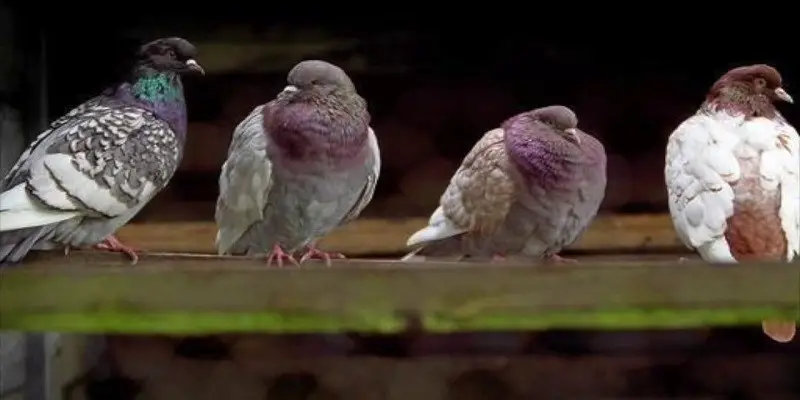There are many different types of pigeons, but all of them make similar sounds. A pigeon typically coos, which is a soft, gentle sound. Sometimes, however, a pigeon will make a louder noise if it is alarmed or excited.
What kind of noises and sounds do pigeons make
If you ask most people what a pigeon sounds like, they’ll probably say “coo.” But that’s not the only sound pigeons make. Depending on the species, pigeons can also make a variety of other noises, including cooing, purring, grunting, and even hissing.
One of the most common pigeon sounds is cooing. Pigeons typically coo when they’re content or trying to attract a mate. Cooing is a soft, gentle noise that’s often described as being similar to a dove’s call.
If you hear a pigeon cooing, it’s likely because there’s a nest nearby. Purring is another common sound made by pigeons. This noise is usually made while the bird is preening itself or when it’s content and relaxed.
Purring typically sounds like a low-pitched hum or buzz and can be quite soothing to listen to. Grunting is another noise made by some species of pigeons and is usually reserved for situations where the bird feels threatened or alarmed. Grunting noises can vary in intensity but are generally quite loud and harsh-sounding.
If you hear a pigeon grunting, it’s best to give it some space as it may be feeling agitated. Finally, some pigeons also make hissing noises when they’re angry or afraid. Hissing usually sounds like air being released from a balloon and can be quite startling if you’re not expecting it.
If you see a pigeon making this noise, it’s best to back away slowly as the bird may be feeling threatened and could become aggressive.
Pigeon Sound Meaning
If you’ve ever been around pigeons, you know that they make a variety of sounds. But what do those sounds mean? Pigeons use sound to communicate a variety of things, from simple messages like “I’m hungry” to more complicated emotions like fear or excitement.
Scientists have studied pigeon vocalizations and have found that there are at least 24 different types of coos, each with its own meaning. Here are some of the most common pigeon sounds and what they mean: Cooing: This is the most basic form of communication and is used to express a variety of things, including hunger, contentment, or desire for attention.
Crooning: A soft, gentle coo that is often used as part of courtship rituals. It can also be used to comfort other pigeons. Purring: A low-pitched sound that indicates pleasure or contentment.
You might hear this sound when a pigeon is being petted or if it’s enjoying a good meal. Gurgling: A happy sound that indicates excitement or anticipation. Gurgling is often heard during courtship displays or when another pigeon comes close to the gurgler’s territory.

Credit: www.youtube.com
What Sound Does the Pigeon Make?
Pigeons make a variety of sounds, depending on their mood and the situation. Common pigeon vocalizations include cooing, purring, hissing, and chirping. Cooing is the most common sound that pigeons make.
It is a low, soft, soothing sound that is used to communicate contentment or affection. Pigeons will often coo when they are being petted or when they are around other pigeons that they like. Purring is another common sound that pigeons make.
It is similar to cooing but is usually louder and more persistent. Purring can be used to express both positive and negative emotions in pigeons – it can signal contentment or pleasure, but it can also be a sign of annoyance or stress. Hissing is a less common vocalization that pigeons use to show aggression or fear.
When a pigeon hisses, it makes a sharp “hissing” noise with its beak open wide. This noise is meant to intimidate opponents and warn them off from attacking or approaching further. Chirping is a brief, high-pitched sound that pigeons sometimes make as part of their mating ritual.
During courtship displays, male pigeons will often “chirp” to attract female mates.
What Do Pigeon Noises Mean?
Pigeon noises can mean a lot of things. For example, cooing is often used as a way to express affection, while squawking can be a sign of aggression or fear. Pigeons also make a variety of other sounds, including chirping, clicking and purring.
Each of these noises has a different meaning and can be used to communicate different emotions or messages.
What Noise Do Pigeons Make When They Fly?
Pigeons make a wide variety of sounds, from the distinctive coo of mating pairs to the loud squabble of birds fighting over food. However, the noise that pigeons are most commonly associated with is the sound of their wings flapping as they fly. This noise is caused by the air passing over the pigeon’s wing feathers, and it can be quite loud when a large flock of pigeons takes off at once.
Conclusion
If you’ve ever wondered what a pigeon sounds like, you’re not alone. These birds are actually quite vocal, and they have a variety of coos and calls that they use to communicate with each other. Pigeons make three main types of sounds: coos, purrs, and warbles.
Coos are the most common sound that pigeons make, and they use them for both greeting other pigeons and communicating distress. Purrs are softer than coos, and pigeons usually only make them when they’re content or trying to calm another bird down. Warbles are the most complex of the three sounds, and pigeons use them to communicate excitement or warning.
So next time you hear a pigeon cooing in the park, take a moment to appreciate the beautiful music these creatures can make!
Last Updated on January 14, 2025 by Pauline G. Carter

